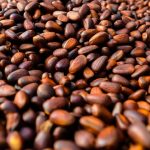Lauric acid is a saturated fatty acid with the chemical formula C₁₂H₂₄O₂. It is also known as dodecanoic acid. Lauric acid is found in various natural sources, with the highest concentrations in coconut oil and palm kernel oil. It is also present in small amounts in milk and dairy products.
Key Characteristics of Lauric Acid
- Molecular Structure: Lauric acid has a 12-carbon atom chain, making it a medium-chain fatty acid (MCFA).
- Physical Properties: At room temperature, lauric acid is a white, powdery solid with a faint odour resembling bay oil or soap. It melts at approximately 44°C (111°F).
- Chemical Properties: Lauric acid is relatively stable and non-reactive. It is insoluble in water but soluble in organic solvents.
Sources of Lauric Acid
- Coconut Oil: Contains about 45-50% lauric acid.
- Palm Kernel Oil: Contains around 45-55% lauric acid.
- Human and Animal Milk: Contains lower concentrations of lauric acid.
Uses of Lauric Acid
- Industrial Applications:
- Soap and Detergent Production: Lauric acid is a key ingredient in the manufacture of soaps and detergents due to its excellent foaming and cleansing properties.
- Cosmetics and Personal Care Products: Used in shampoos, lotions, and other personal care items for its moisturizing and antibacterial properties.
- Surfactants: Employed in the production of surfactants, which are compounds that lower the surface tension between two substances, such as oil and water.
- Food Industry:
- Food Additive: Used as a food additive and emulsifier in various processed foods.
- Nutritional Supplement: Included in some dietary supplements for its potential health benefits, such as antimicrobial and antiviral properties.
- Pharmaceuticals:
- Drug Delivery: Utilized in the formulation of certain pharmaceuticals for its ability to enhance the solubility and bioavailability of drugs.
Health Aspects
- Antimicrobial Properties: Lauric acid has demonstrated antimicrobial and antiviral activities, making it effective against certain bacteria, viruses, and fungi.
- Metabolism: As a medium-chain fatty acid, lauric acid is more readily metabolized by the body compared to long-chain fatty acids, which means it can be a quick source of energy.
Lauric Acid vs. Non-Lauric Fats
In the context of chocolate and confectionery production, non-lauric fats (like those used in Cocoa Butter Equivalents) are preferred over lauric fats (such as palm kernel oil) because:
- Compatibility with Cocoa Butter: Non-lauric fats are more compatible with cocoa butter, which helps in maintaining the desired texture and prevents fat bloom in chocolate products.
- Stability: Non-lauric fats offer better stability and consistency in the final product.
Lauric acid is a versatile fatty acid widely used in industrial, food, and pharmaceutical applications due to its unique properties and benefits.


Leave a Reply